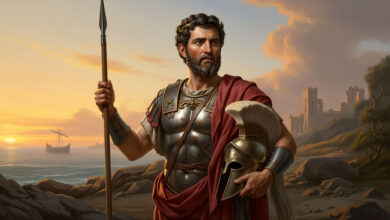Among the sailors of the great American whaling era, no figure looms larger or more haunted than Captain Ahab of the Pequod. Part visionary, part madman, he was a commander whose name became a warning whispered in every harbour. His pursuit of the great white whale that maimed him remains one of the most extraordinary and cautionary tales in maritime history, a study in obsession, courage, and the limits of human defiance against the natural world.
Early Life and the Call to the Sea
Ahab was born in Nantucket at the turn of the nineteenth century, a time when the island’s fortunes were tied to whaling. His father was lost at sea before Ahab was old enough to walk, and his mother died soon after, leaving him to be raised by seafaring relatives and the community’s rough code of faith and endurance. From childhood, he was drawn to the ocean, not merely for a livelihood but for an unshakable sense that his destiny lay there.
By his late teens, he was already a seasoned sailor. Whaling ships of the era were floating worlds, part factory, part monastery, part battlefield. Ahab rose quickly through the ranks, admired for his intelligence, courage, and the near-religious discipline he demanded of himself and his crew.
The Captain of the Pequod
By his mid-thirties, Ahab had taken command of the Pequod, a stout three-masted whaler built in Nantucket and known for long voyages into the southern oceans. He earned a reputation as a fair but fearsome leader. He neither drank nor gambled, spoke little in port, and lived for the hunt. His crew, drawn from every corner of the globe, respected him for his precision and unflinching courage during the brutal work of killing whales and rendering their oil.
It was on one of these voyages, deep in the Pacific, that fate marked him forever. A massive albino sperm whale, a creature sailors called Moby Dick, struck the ship’s whaleboats without warning and bit off Ahab’s leg below the knee before vanishing into the depths.
Ahab survived, but the encounter changed him completely. The whalebone prosthetic that replaced his leg became both symbol and burden. Where once he had been a disciplined seaman, he returned to Nantucket a man consumed by a single thought: vengeance upon the whale that had taken his limb and, in his mind, his humanity.
The Final Voyage
In the spring of 1840, Ahab set sail once more aboard the Pequod. Officially, it was to be another whaling voyage, routine, profitable, and long. Unofficially, it was something else entirely.
From the beginning, those on board sensed that this would not be an ordinary hunt. The ship carried a multinational crew: Starbuck, the steady Quaker first mate; Stubb, cheerful but fatalistic; Flask, blunt and fearless; and a harpooner named Queequeg, renowned among whalers for his strength and honour. Above them all stood Ahab, whose presence seemed to bend the very air around him.
For the first weeks, the voyage followed the pattern of any whaling expedition, sightings, pursuits, the long, grim labour of cutting blubber and boiling oil. But as the Pequod sailed deeper into the southern oceans, Ahab began to reveal his true purpose. Standing before the crew, he drove a gold coin into the mast and declared it the prize for the man who first sighted the white whale.
From that moment, the ship became a vessel of obsession. Routine gave way to ritual. Each new whale that appeared was ignored unless it was white. The officers muttered of blasphemy; the crew whispered of madness. But Ahab’s charisma, fuelled by his towering will, held them fast.
The Nature of the Hunt
Ahab’s pursuit of the whale was more than revenge; it was rebellion. He saw in Moby Dick not merely a beast but a symbol of all that mocked human purpose: nature’s indifference, divine cruelty, fate itself. “To strike through the mask,” he was heard to say, as if he meant to wound not the animal but the hidden power behind it.
He became the embodiment of the tragic seafarer, brilliant, fearless, and doomed by the very fire that made him extraordinary. His men followed him partly out of loyalty, partly out of fear, and partly because his defiance spoke to something deep within every sailor who had ever faced the ocean’s merciless vastness.
Weeks turned into months. The Pequod crossed every ocean, from the Cape of Good Hope to the Java Sea, ignoring storms and mutinous murmurs alike. When other captains hailed him with warnings or news, Ahab’s only question was whether they had seen the white whale.
The Encounter
After more than a year at sea, the Pequod entered the waters near the equator. There, in a calm sea glimmering like glass, lookouts sighted the creature that had haunted their captain’s dreams. What followed has passed into maritime legend.
For three days, the Pequod pursued the whale. The ocean boiled with fury as the enormous creature smashed boats, snapped harpoons, and defied all human effort to subdue it. Ahab fought as though possessed, his voice carrying across the waves, urging his men onward even as the ship itself began to splinter.
On the final day, as the whale rammed the Pequod and opened its hull, Ahab cast his last harpoon. Lines tangled; the rope wrapped around him; and he was dragged beneath the sea, vanishing into the depths with the very creature he sought to destroy. The ship followed soon after, swallowed by the ocean in a whirl of timber and foam.
Only one sailor survived to tell the tale, clinging to a floating coffin until rescued by another vessel. The sea, indifferent as ever, closed over the rest.
Interpretations and Legacy
In the years that followed, seafarers and scholars alike debated the meaning of Captain Ahab’s life. To some, he was a hero, a man who refused to submit to fate, whose defiance elevated him above ordinary mortals. To others, he was a warning, proof that obsession can destroy not only its victim but all who follow him.
Maritime historians point out that Ahab’s tragedy mirrored the age itself. The whaling industry, once a symbol of human mastery over nature, was already nearing its decline. Steam power began to replace the sail, and petroleum would soon replace whale oil. In that sense, Ahab was the last of a breed, a man who stood at the edge of history, raging against a future that had no place for his kind.
His story also illuminates the psychology of leadership. Ahab commanded absolute loyalty because he embodied conviction, even when wrong. He showed that charisma, when coupled with obsession, can inspire devotion or destruction in equal measure.
The Man Behind the Myth
Those who knew Ahab before his final voyage remembered a different man: solitary but kind, capable of humour, and respected for his intelligence. The transformation after his injury was profound. Some claimed it was not madness but grief, not hatred of the whale, but hatred of his own helplessness.
In private logs and journals recovered from earlier voyages, he wrote of the sea with both reverence and fear. “The ocean,” one entry reads, “is the mirror of the soul. In its calm, deceit; in its storm, truth.” That sentence, if indeed his, reveals a man who understood his own doom but could not turn aside from it.
Historical Reflections
Whether viewed as a hero, victim, or warning, Captain Ahab remains one of the most enduring figures of maritime history. His life captures the essence of an era when men measured themselves against the elements, and when the pursuit of mastery often ended in ruin.
Modern scholars see in him the archetype of the modern individual, isolated, ambitious, and tormented by the search for meaning in an indifferent universe. His ship, the Pequod, has come to represent humanity itself: diverse, restless, and bound to a destiny of its own making.
Final Word
Captain Ahab’s story is not merely that of a man and a whale, but of humanity’s struggle against the limits of knowledge and control. He reminds us that obsession, when fused with purpose, can either ennoble or destroy. In seeking to conquer the unknowable, he became both martyr and monster, a figure at once terrifying and magnificent. The sea took his body, but his legend endures. Every captain who stands at the helm and feels the humbling power of the open ocean carries a trace of Ahab’s defiance. He remains the eternal mariner, scarred, relentless, and forever chasing the horizon.
Captain Ahab FAQ
Captain Ahab was a 19th-century American whaling captain from Nantucket, remembered for his relentless pursuit of a giant white whale that had maimed him.
His life represents the dangers of obsession and the human struggle to confront forces beyond control, making him one of literature’s most complex figures.
He lived during the height of the 19th-century whaling industry, when American ships sailed the globe in search of whale oil.
His story teaches the consequences of letting obsession overrule reason and reminds us that courage without humility often leads to destruction.
He remains a symbol of humanity’s desire to master nature, and his tale continues to inspire discussions about ambition, leadership, and fate.




